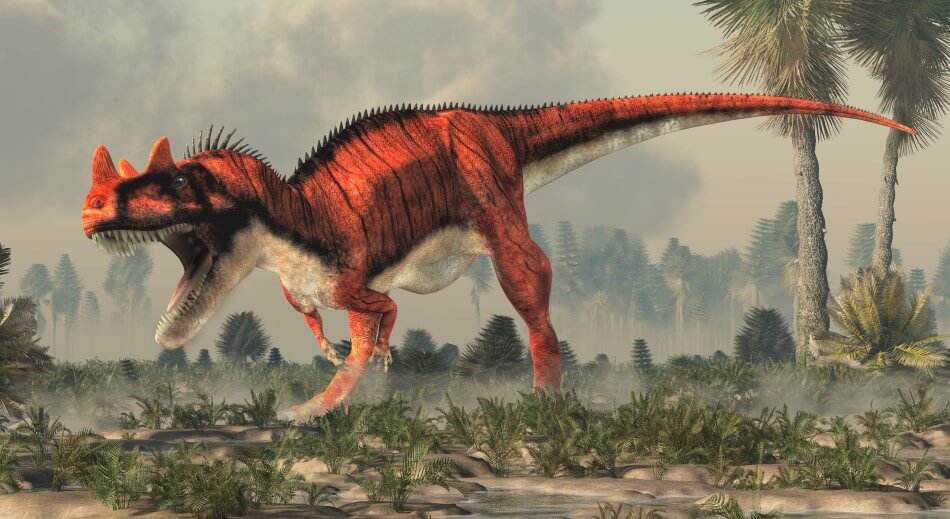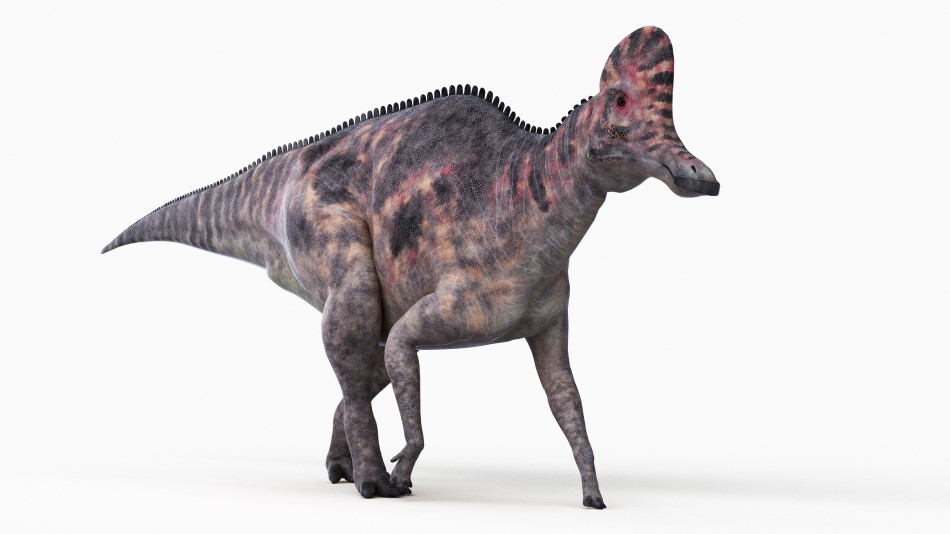From the small Compsognathus, made famous by the Jurassic Park movies, to the lumbering and long-necked Camarasaurus, there’s lots of interesting dinosaurs beginning with the letter C.
Carnivores (meat eaters), herbivores (plant eaters) and even omnivores (both meat and plant!) can be found within this section of the dinosaur alphabet. Don’t forget to take a look at dinosaurs beginning with other letters, as well as our general dinosaur facts.
Explore Dinosaur Species
Explore the Dinosaur A to Z
- Dinosaurs beginning with C
Camarasaurus
Camarasaurus, meaning Greek for “chambered lizard”, was pronounced cam-AH-rah-SORE-us. It was a herbivore that was found in the Plains of North America during the Late Jurassic period, around 150-145 million years ago. It was 60 feet long and weighed around 20 tons, and it’s notable characteristics were: Large, boxy skull; hollow vertebrae; single claw on front feet.
Camptosaurus
Camptosaurus, meaning Greek for “bent lizard”, was pronounced CAMP-toe-SORE-us. It was a herbivore that was found in the Woodlands of North America during the Late Jurassic period, around 155-145 million years ago. It was 20 feet long and weighed around 1-2 tons, and it’s notable characteristics were: Four toes on back feet; long, narrow snout with hundreds of teeth.
Caudipteryx
Caudipteryx, meaning Greek for “tail feather”, was pronounced cow-DIP-ter-ix. It was a herbivore that was found in the Lakesides and riverbeds of Asia during the Early Cretaceous period, around 120-130 million years ago. It was three feet long and weighed around 20 pounds, and it’s notable characteristics were: Primitive feathers; birdlike beak and feet.
Centrosaurus
Centrosaurus, meaning Greek for “pointed lizard”, was pronounced SEN-tro-SORE-us. It was a herbivore that was found in the Woodlands of western North America during the Late Cretaceous period, around 75 million years ago. It was 20 feet long and weighed around three tons, and it’s notable characteristics were: Single, long horn on end of snout; moderate size; large frill over head.
Cerasinops
Cerasinops, meaning Greek for “lesser horned face”, was pronounced SEH-rah-SIGH-nops. It was a herbivore that was found in the Woodlands of North America during the Late Cretaceous period, around 85 million years ago. It was eight feet long and weighed around 400 pounds, and it’s notable characteristics were: Relatively small size; blunt head with horned beak.
Ceratonykus
Ceratonykus, meaning Greek for “horned claw”, was pronounced seh-RAT-oh-NIKE-us. It was a Carnivore that was found in the Deserts of central Asia during the Late Cretaceous period, around 85-80 million years ago. It was five feet long and weighed around 25 pounds, and it’s notable characteristics were: Small size; bipedal posture; probably feathers.
Ceratosaurus

Ceratosaurus, meaning Greek for “horned lizard”, was pronounced seh-RAT-oh-SORE-us. It was a Carnivore, fish, and reptiles that was found in the Swamps of southern North America during the Late Jurassic period, around 150-145 million years ago. It was 15 feet long and weighed around one-ton, and it’s notable characteristics were: Row of bony plates on back; small horns on head; sharp teeth; bipedal posture.
Cetiosauriscus
Cetiosauriscus, meaning Greek for “like Cetiosaurus”, was pronounced see-tee-oh-SORE-iss-kuss. It was a herbivore that was found in the Woodlands of western Europe during the Late Jurassic period, around 160 million years ago. It was 50 feet long and weighed around 15-20 tons, and it’s notable characteristics were: Long neck and tail; squat trunk.
Cetiosaurus
Cetiosaurus, meaning Greek for “whale lizard”, was pronounced SEE-tee-oh-SORE-us. It was a herbivore that was found in the Plains of western Europe and northern Africa during the Late Jurassic period, around 170-160 million years ago. It was 50 feet long and weighed around 10 tons, and it’s notable characteristics were: Long neck and tail; unusually heavy vertebrae.
Changyuraptor
Changyuraptor, meaning Greek for “Changyu thief”, was pronounced CHANG-yoo-rap-tore. It was a Carnivore that was found in the Woodlands of Asia during the Early Cretaceous period, around 125 million years ago. It was three feet long and weighed around 10 pounds, and it’s notable characteristics were: Four wings; long feathers.
Chaoyangsaurus
Chaoyangsaurus, meaning Greek for “Chaoyang lizard”, was pronounced CHOW-yang-SORE-us. It was a herbivore that was found in the Woodlands of Asia during the Middle-Late Jurassic period, around 170-145 million years ago. It was three feet long and weighed around 20-30 pounds, and it’s notable characteristics were: Small size; bipedal posture; horned snout.
Charonosaurus

Charonosaurus, meaning Greek for “Charon lizard”, was pronounced cah-ROAN-oh-SORE-us. It was a herbivore that was found in the Woodlands of Asia during the Late Cretaceous period, around 70-65 million years ago. It was 40 feet long and weighed around 6 tons, and it’s notable characteristics were: Large size; long, narrow crest on head.
Chasmosaurus
Chasmosaurus, meaning Greek for “cleft lizard”, was pronounced KAZZ-moe-SORE-us. It was a herbivore that was found in the Woodlands of western North America during the Late Cretaceous period, around 75-70 million years ago. It was 15 feet long and weighed around 2 tons, and it’s notable characteristics were: Huge, rectangular frill on neck; small horns on face.
Chindesaurus
Chindesaurus, meaning Greek for “Chinde Point lizard”, was pronounced CHIN-deh-SORE-us. It was a Carnivore that was found in the Swamps of North America during the Late Triassic period, around 225 million years ago. It was 10 feet long and weighed around 20-30 pounds, and it’s notable characteristics were: Relative large size; long legs and long, whiplike tail.
Chirostenotes
Chirostenotes, meaning Greek for “narrow hand”, was pronounced KIE-ro-STEN-oh-tease. It was likely omnivorous that was found in the Woodlands of North America during the Late Cretaceous period, around 80 million years ago. It was seven feet long and weighed around 50-75 pounds, and it’s notable characteristics were: Narrow, clawed fingers on hands; toothless jaws.
Chubutisaurus
Chubutisaurus, meaning Greek for “Chubut lizard”, was pronounced CHOO-boo-tih-SORE-us. It was a herbivore that was found in the Woodlands of South America during the Early Cretaceous period, around 110-100 million years ago. It was 60 feet long and weighed around 10-15 tons, and it’s notable characteristics were: Large size; long neck and tail.
Citipati
Citipati, meaning after an ancient Hindu god, was pronounced SIH-tee-PAH-tee. It was a Carnivore that was found in the Plains of central Asia during the Late Cretaceous period, around 75 million years ago. It was nine feet long and weighed around 500 pounds, and it’s notable characteristics were: Crest on front of head; toothless beak.
Claosaurus
Claosaurus, meaning Greek for “broken lizard”, was pronounced CLAY-oh-SORE-us. It was a herbivore that was found in the Woodlands of North America during the Late Cretaceous period, around 80-70 million years ago. It was 15 feet long and weighed around 1,000 pounds, and it’s notable characteristics were: Relatively small size; long tail.
Coahuilaceratops
Coahuilaceratops, meaning Greek for “Coahuila horned face”, was pronounced CO-ah-HWEE-lah-SEH-rah-tops. It was a herbivore that was found in the Woodlands of North America during the Late Cretaceous period, around 72 million years ago. It was 22 feet long and weighed around 2-3 tons, and it’s notable characteristics were: Enormous head with long, paired, curving horns.
Coelurus
Coelurus, meaning Greek for “hollow tail”, was pronounced see-LORE-us. It was a Carnivore that was found in the Woodlands of North America during the Late Jurassic period, around 150 million years ago. It was seven feet long and weighed around 50 pounds, and it’s notable characteristics were: Small size; slender hands and feet.
Compsognathus

Compsognathus, meaning Greek for “pretty jaw”, was pronounced komp-sog-nuh-thus. It was a Carnivore that was found in the Europe during the late Jurassic period, around 155 million years ago. It was 2-3 feet long and weighed around 12 pounds, and it’s notable characteristics were: swift speed, long neck and tail, strong hind limbs and very small forelimbs (arms).
Concavenator
Concavenator, meaning Greek for “Cuenca hunter”, was pronounced con-CAV-eh-nate-or. It was a Carnivore that was found in the Woodlands of western Europe during the Early Cretaceous period, around 130 million years ago. It was 20 feet long and weighed around 2-3 tons, and it’s notable characteristics were: Triangular hump on lower back; possible feathers on forearms.
Conchoraptor
Conchoraptor, meaning Greek for “conch thief”, was pronounced CON-coe-rap-tore. It was likely omnivorous that was found in the Swamps of Central Asia during the Late Cretaceous period, around 70 million years ago. It was five feet long and weighed around 20 pounds, and it’s notable characteristics were: Small size; well-muscled jaws.
Condorraptor
Condorraptor, meaning Greek for “condor thief”, was pronounced CON-door-rap-tore. It was a Carnivore that was found in the Woodlands of South America during the Middle Jurassic period, around 175 million years ago. It was 15 feet long and weighed around 400 pounds, and it’s notable characteristics were: Bipedal stance; medium size.
Coronosaurus
Coronosaurus, meaning Greek for “crown lizard”, was pronounced core-OH-no-SORE-us. It was a herbivore that was found in the Woodlands of North America during the Late Cretaceous period, around 75 million years ago. It was 15 feet long and weighed around 2 tons, and it’s notable characteristics were: Moderate size; prominent horn and frill.
Corythosaurus

Corythosaurus, meaning Greek for “Corinthian-helmet lizard”, was pronounced core-ITH-oh-SORE-us. It was a herbivore that was found in the Forests and plains of North America during the Late Cretaceous period, around 75 million years ago. It was 30 feet long and weighed around five tons, and it’s notable characteristics were: Large, bony crest on head; ground-hugging, quadrupedal posture.
Cryptovolans
Cryptovolans, meaning Greek for “hidden flyer”, was pronounced CRIP-toe-VO-lanz. It was a Carnivore that was found in the Woodlands of Asia during the Early Cretaceous period, around 130-120 million years ago. It was three feet long and weighed around 5-10 pounds, and it’s notable characteristics were: Long tail; feathers on front and hind limbs.
Cumnoria
Cumnoria, meaning after Cumnor Hirst, a hill in England, was pronounced kum-NOOR-ee-ah. It was a herbivore that was found in the Woodlands of western Europe during the Late Jurassic period, around 155 million years ago. It was 20 feet long and weighed around one ton, and it’s notable characteristics were: Stiff tail; bulky torso; quadrupedal posture.
